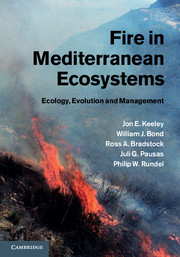Section I - Introduction
Published online by Cambridge University Press: 05 January 2012
Summary
Introduction
A significant portion of Earth is subject to periodic fires. There is a paradox in that these fire-prone landscapes have historically been interpreted in terms of just climate and geology, with limited consideration of the evolutionary and ecological role that fire has had in shaping functional types and community assembly. The theme throughout this book is that plant traits and plant communities over much of the fire-prone portions of the globe cannot be understood without consideration of the climate–fire–geology filter that controls the assembly of these systems. One rationale for focusing on mediterranean-type climate (MTC) regions is that vast portions of these landscapes are annually subjected to high fire risk. High fire danger is a consequence of climate and plant structure and many features of both are shared between the five MTC regions. These ecosystems in widely disjunct parts of the globe are tied together by a long history of convergent evolution/ecology studies that began with nineteenth-century geographic comparisons of plant morphologies. These early geographers were “fire-blind” in failing to recognize some of the most critical factors responsible for convergence. Indeed, even very keen observers such as Charles Darwin visited the highly fire-prone Eucalyptus woodland of Australia and failed to appreciate the extraordinary story of fire adaptation on this landscape. Substantial scientific focus on these ecosystems over the past several decades has provided a wealth of background information necessary for interpreting the role of fire in driving the degree of convergence in plant traits and community assembly, as well as insights into reasons for examples of non-convergence between these regions.
- Type
- Chapter
- Information
- Fire in Mediterranean EcosystemsEcology, Evolution and Management, pp. 1 - 2Publisher: Cambridge University PressPrint publication year: 2011



